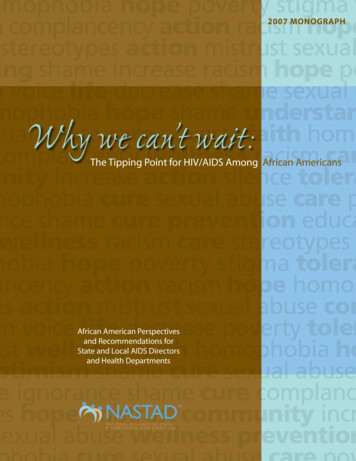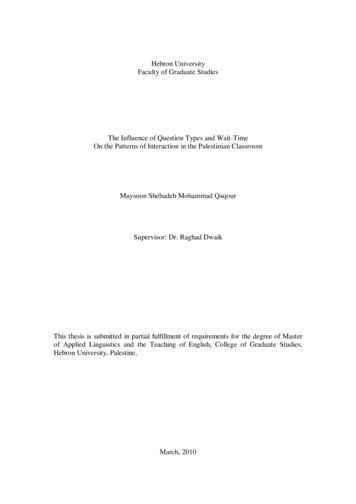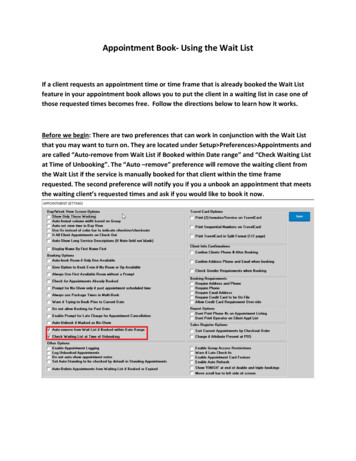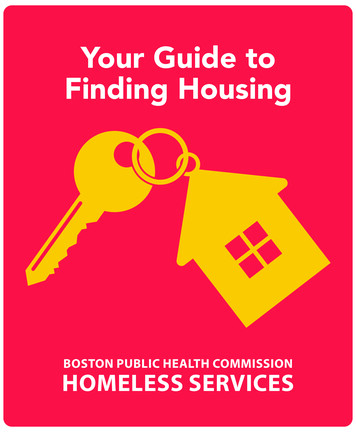
Transcription
2007 MONOGRAPHWhy we can’t wait:The Tipping Point for HIV/AIDS Among African AmericansAfrican American Perspectivesand Recommendations forState and Local AIDS Directorsand Health Departments
Why we can’t wait:“NASTAD, as the unified voice of U.S. state andterritorial AIDS directors, is committed to this enormouschallenge. We continue ever-vigilant in the fight againstHIV/AIDS, bringing greater attention and focus tothe unacceptable disparities in HIV/AIDS in AfricanAmerican communities across the country.”Julie M. ScofieldNASTAD Executive Director
The Tipping Point for HIV/AIDS Among African AmericansTable of ContentsExecutive Summary. . . . . . . . . . . . . . . . . . . . . . . . . . . . . . . . . . . . . . . . . . . . . . . . . . 3Introduction. . . . . . . . . . . . . . . . . . . . . . . . . . . . . . . . . . . . . . . . . . . . . . . . . . . . . . . 6Key Issues and Successful Strategies . . . . . . . . . . . . . . . . . . . . . . . . . . . . . . . . . . . . . . . . . . . . . . . . . . . . . . . . . . . . . . . . . . . . . . . . . . . . 9An Epidemiological Perspective on HIV/AIDS in African American Communities. . . . . . . . . . . . . . . . . . . . . . . . . 9 A Successful Strategy from Michigan . . . . . . . . . . . . . . . . . . . . . . . . . . . . . . . . . . . . . . . . . 15Capacity Building. . . . . . . . . . . . . . . . . . . . . . . . . . . . . . . . . . . . . . . . . . . . . . . . . . . . . . . . . . . . . . . . . . . . . . . . . . . . . . . . . . . . . . . . . . . . . . . . . . . . . . . . . . . . . . 17 A Successful Strategy from New York . . . . . . . . . . . . . . . . . . . . . . . . . . . . . . . . . . . . . . . . . 19Coalition and Partnership Building. . . . . . . . . . . . . . . . . . . . . . . . . . . . . . . . . . . . . . . . . . . . . . . . . . . . . . . . . . . . . . . . . . . . . . . . . . . . . . . . . . . . . . 21 A Successful Strategy from Maryland. . . . . . . . . . . . . . . . . . . . . . . . . . . . . . . . . . . . . . . . . 23Program Implementation. . . . . . . . . . . . . . . . . . . . . . . . . . . . . . . . . . . . . . . . . . . . . . . . . . 25 A Successful Strategy from Wisconsin. . . . . . . . . . . . . . . . . . . . . . . . . . . . . . . . . . . . . . . . . . . . . . . . . . . . . . . . . . . . . . . . . . . . . . . . . . . . . . . . 28Behavioral Research. . . . . . . . . . . . . . . . . . . . . . . . . . . . . . . . . . . . . . . . . . . . . . . . . . . . . . . . . . . . . . . . . . . . . . . . . . . . . . . . . . . . . . . . . . . . . . . . . . . . . . . . . . 30 A Successful Strategy from Illinois . . . . . . . . . . . . . . . . . . . . . . . . . . . . . . . . . . . . . . . . . . . 33Appendices . . . . . . . . . . . . . . . . . . . . . . . . . . . . . . . . . . . . . . . . . . . . . . . . . . . . . . . . . . . . . . . . . . . . . . . . . . . . . . . . . . . . . . . . . . . . . . . . . . . . . . . . . . . . 35Appendix 1: Comprehensive List of Recommendations. . . . . . . . . . . . . . . . . . . . . . . . . . . . . . . 35Appendix 2: Health Department Self-Assessment Tool . . . . . . . . . . . . . . . . . . . . . . . . . . . . . . . . . . . . . . . . . . . . . . . . . . . . . . . . . . . . . . 41Appendix 3: Other Successful Strategies . . . . . . . . . . . . . . . . . . . . . . . . . . . . . . . . . . . . . . . . . . . . . . . . . . . . . . . . . . . . . . . . . . . . . . . . . . . . . . . . 45 California. . . . . . . . . . . . . . . . . . . . . . . . . . . . . . . . . . . . . . . . . . . . . . . . . . . . . . . . . . . 45 Florida . . . . . . . . . . . . . . . . . . . . . . . . . . . . . . . . . . . . . . . . . . . . . . . . . . . . . . . . . . . . . . . . . . . . . . . . . . . . . . . . . . . . . . . . . . . . . . . . . . . . . . . . . . . . . . . . . . . . . . . . 47 Illinois. . . . . . . . . . . . . . . . . . . . . . . . . . . . . . . . . . . . . . . . . . . . . . . . . . . . . . . . . . . . . 50 Louisiana. . . . . . . . . . . . . . . . . . . . . . . . . . . . . . . . . . . . . . . . . . . . . . . . . . . . . . . . . . . 52 Maryland (2). . . . . . . . . . . . . . . . . . . . . . . . . . . . . . . . . . . . . . . . . . . . . . . . . . . . . . . . . 54 Minnesota. . . . . . . . . . . . . . . . . . . . . . . . . . . . . . . . . . . . . . . . . . . . . . . . . . . . . . . . . . . . . . . . . . . . . . . . . . . . . . . . . . . . . . . . . . . . . . . . . . . . . . . . . . . . . . . . . . . . 58 Nebraska . . . . . . . . . . . . . . . . . . . . . . . . . . . . . . . . . . . . . . . . . . . . . . . . . . . . . . . . . . . 61 New Jersey . . . . . . . . . . . . . . . . . . . . . . . . . . . . . . . . . . . . . . . . . . . . . . . . . . . . . . . . . . . . . . . . . . . . . . . . . . . . . . . . . . . . . . . . . . . . . . . . . . . . . . . . . . . . . . . . . . 63 North Carolina. . . . . . . . . . . . . . . . . . . . . . . . . . . . . . . . . . . . . . . . . . . . . . . . . . . . . . . . . . . . . . . . . . . . . . . . . . . . . . . . . . . . . . . . . . . . . . . . . . . . . . . . . . . . . . 65Appendix 4: Sample Job Description for Minority AIDS Coordinator Position (2) . . . . . . . . . . . . . . . 67References. . . . . . . . . . . . . . . . . . . . . . . . . . . . . . . . . . . . . . . . . . . . . . . . . . . . . . . . . . . . . . . . . . . . . . . . . . . . . . . . . . . . . . . . . . . . . . . . . . . . . . . . . . . . . . 69
Why we can’t wait:
The Tipping Point for HIV/AIDS Among African AmericansExecutive SummaryIn 2001, the National Alliance of State and TerritorialAIDS Directors (NASTAD) released the monograph,HIV/AIDS: African American Perspectives andRecommendations for State and Local AIDS Directors andHealth Departments. The intent of the document wasto increase synergy between the public health systemand African American communities in order to halt thedevastation of HIV/AIDS. Since the release of the 2001monograph, many state and local health departmentsfurther responded to the AIDS crisis in African Americancommunities by allocating additional funding, designingand implementing innovative programming, anddedicating staff and other resources to confront thecrisis. Unfortunately, these and other efforts have notproven entirely successful in decreasing national rates ofnew HIV infections among African Americans.to further heighten the response to HIV/AIDS in theAfrican American community by calling for coordinatedand decisive action from health departments and thecommunities they serve. In epidemiology, the term‘tipping point’ characterizes the point at which anepidemic reaches critical mass, when a seemingly rareoutbreak has proliferated into a legitimate public-healthcrisis. HIV/AIDS tipped many years ago and has since hada devastating impact on African American communities.This monograph hopes to catalyze a second tippingpoint, a time when all efforts in the fight against HIV/AIDS begin to come together to create a meaningful andunified response that ultimately reduces new infectionsand ensures access to quality care and treatment forindividuals living with HIV/AIDS.Opinions vary as to the primary reasons this epidemiccontinues to ravage African American communities.Research suggests that issues like the lack of qualityhealth care, inadequate education, poverty, and lack ofsubstantive empirical research on the various conditionsthat advance disease proliferation and progression,among other factors, all contribute to the sustainedimpact on African Americans. The U.S. Department ofHealth and Human Services (HHS) initiative, HealthyPeople 2010, states explicitly that “inequalities in incomeand education underlie many health disparities in theUnited States” and that a multidisciplinary approach isnecessary to reduce or eliminate these disparities.1 Basedon the tipping point concept, small advances in any orall of these areas can potentially result in large effectsand positive change for African American communities.This updated edition of the 2001 monograph intendsto advance this theory through presentation ofperspectives, questions, potential remedies, andstrategies, each of which may create the necessarymomentum to have a legitimate impact on rates of HIV/AIDS infection in African American communities.In epidemiology, the term ‘tipping point’characterizes the point at which an epidemicreaches critical mass, when a seemingly rareoutbreak has proliferated into a legitimatepublic-health crisis. HIV/AIDS tipped many yearsago and has since had a devastating impact onAfrican American communities. This monographhopes to catalyze a second tipping point, a timewhen all efforts in the fight against HIV/AIDSbegin to come together to create a meaningfuland unified response that ultimately reduces newinfections and ensures access to quality care andtreatment for individuals living with HIV/AIDS.In response to this growing epidemic, NASTAD updatedits strategic map in 2006 to reflect a renewed andfocused approach to addressing the HIV epidemic incommunities of color. Consistent with the updatedstrategic map, the ever-changing political landscape, andthe advent of new technologies, NASTAD is releasingthis updated version of its 2001 monograph. The revisedmonograph—Why We Can’t Wait: The Tipping Pointfor HIV/AIDS in African American Communities—seeksAs with the 2001 document, this revised monograph isdesigned to encourage state and local AIDS directorsto continue enhancing their work, refining promisingapproaches, and investigating new methodologiesand models. Additionally, the monograph reiteratescertain sociocultural factors, considers new factors, anddescribes how these factors conspire to undermine
Why we can’t wait:even the best efforts of health departments working toreduce HIV infections among African Americans. Theimportance of sociocultural factors such as historicalunderpinnings, cultural norms, external factors (e.g.,poverty and racism), and access barriers cannot beoverstated.public health agencies are entrusted through U.S. lawto be the “central authorities of the nation’s publichealth system” and, as such, bear primary public sectorresponsibility for the health of their communities.2Therefore, state and local health departments are keypartners and leaders in this heightened response tofighting HIV/AIDS in African American communities.This updated monograph also aims to assist AIDSdirectors in developing collaborations with AfricanAmerican communities to more effectively advocateon their behalf. To achieve this purpose, the updatedmonograph: Examines the Sociocultural Factors thatAffect HIV/AIDS Among African AmericansThis document examines the socioculturalfactors that contribute to the HIV/AIDS epidemicamong African American communities. Usingthese factors as a framework, state and localhealth departments can help appropriatelyshape future responses and programs to addressthe crisis.Public health agencies are the first line of defensefor HIV/AIDS programming targeting AfricanAmericans and other communities.Using the framework outlined above, we can beginto critically explore the public health response toHIV/AIDS for African Americans and examine therelationship between African Americans and publichealth. To effectively lead, health departments mustgive voice to topics that have historically been avoidedand unaddressed. Understanding the underlyingsociocultural factors, like systematic and generationaltrauma and stigma, can help AIDS directors shape,develop, and implement sound programs to combat HIV/AIDS among African Americans in their jurisdictions. Revisits Key IssuesThis monograph explores key issues in the areasof epidemiology, capacity building, coalition andpartnership building, program implementation, andbehavioral research that are specific to the AfricanAmerican experience. Provides RecommendationsThis document builds on the recommendations putforth in the 2001 monograph. NASTAD’s AfricanAmerican Advisory Committee prioritized the 2001recommendations, selecting those they believeneed increased emphasis on the part of state andlocal health departments. Enhancement of theseprioritized recommendations will provide specificsteps and resources for improving the quantity andquality of HIV/AIDS prevention and care services forAfrican American communities.Health departments must also provide proactiveopportunities for leadership development by prioritizinginternal support mechanisms that efficiently preparetheir staff to address this crisis. Key strategies includeprovision of professional development and resourcesand training programs to foster leadership amongAfrican American staff and community stakeholders.This is an important step that AIDS directors must taketo fulfill their leadership mandate of preventing andtreating HIV/AIDS in African American communities.The original monograph included recommendationsfor state and local health departments to addressthe challenges of HIV/AIDS in African Americancommunities. In 2007, NASTAD’s AfricanAmerican Advisory Committee reviewed thoserecommendations and prioritized those that canyield the most robust response in mitigating theepidemic among African Americans. The prioritizedrecommendations are examined further within each ofthe five key issue areas: Usage and Interpretation of Epidemiological Data Acts as a Springboard for Discussion and ActionNASTAD and its African American AdvisoryCommittee want this monograph to serve as aspringboard for pivotal discussions between AfricanAmerican communities, health departments, andnational leaders.A national response to the epidemic among AfricanAmericans recognizes the central role of state healthdepartments in HIV/AIDS prevention and care servicedelivery. Public health agencies are the first line ofdefense for HIV/AIDS programming targeting AfricanAmericans and other communities. Furthermore, state
The Tipping Point for HIV/AIDS Among African Americans Capacity Buildingthese new considerations exist outside the bounds ofthe 2001 recommendations, they are essential to healthdepartments’ ongoing work to combat HIV/AIDS inAfrican American communities. Coalition and Partner ship Building Program Implementation Behavioral ResearchThe revised document is also intended to be usedas a tool to foster stronger linkages between healthdepartments, African American organizations, and withAfrican Americans living with or affected by HIV/AIDS.Where appropriate, “new considerations” are alsopresented under the five key issue areas. The newconsiderations represent knowledge that has beengained since the release of the 2001 monograph. While
Why we can’t wait:IntroductionIn 2001, NASTAD’s African American AdvisoryCommittee (AAAC), comprised of African AmericanHIV/AIDS directors and program staff from state andlocal health departments, along with NASTAD’s ExecutiveCommittee (EC), determined that health departmentsmust make an unwavering commitment to addressingthe HIV/AIDS crisis among African Americans. Thisdetermination led to the development and release ofa monograph, HIV/AIDS: African American Perspectivesand Recommendations for State and Local AIDS Directorsand Health Departments. Although much has changedin the ever-growing AIDS epidemic, much has remainedconstant within African American communities. Overthe past 25 years, the public health community madesignificant strides in addressing the HIV/AIDS epidemic.Yet, despite widespread discussion about the epidemicand some measurable progress in key areas, the overallimpact in African American communities has beennegligible.3 African Americans currently represent morethan half of all HIV/AIDS cases in the U.S.4 The continuedtrajectory of HIV infection among African Americansclearly points to a community in crisis.further support this purpose, the revised monographacknowledges significant events and changes madewithin the past five years in HIV/AIDS prevention andtreatment, while examining the historic underpinningsthat continue to affect HIV/AIDS among AfricanAmericans. An added feature of the updatedmonograph is the pairing of the five key issue areas withsuccessful strategies that highlight best practices fromvarious jurisdictions.Way ForwardThe disparities in African Americans’ health and wellnessin the U.S. and the daunting impact of HIV/AIDS cannotbe questioned or disputed today. Statistics and othermajor indicators point to a community in crisis. Upondeeper consideration, the following questions emerge: Who is responsible for addressing the challengesthat precipitated the spread of HIV/AIDS in the Blackcommunity? What is the responsibility of African Americansthemselves? What is the responsibility of church and faithcommunities?Why We Can’t Wait: The Tipping Point for HIV/AIDSin African American Communities is designed toenhance public health officials’ ability to cultivate adeeper understanding of the needs and concerns ofAfrican Americans and to strengthen collaborationwith African American communities. The updateddocument acknowledges the shifting landscape ofHIV/AIDS and its implications for work that must bedone. This document also details the work of severaljurisdictions that effectively used a number of therecommended strategies and techniques outlined inthe 2001 monograph. This work is presented in theupdated monograph as “successful strategies,” whichinclude community meetings and forums, internal actionplanning, large-scale collaboration with communitystakeholders, and specially-designed programs andinitiatives. What is the responsibility of the public healthsystem in this country? What is the responsibility of AIDS directors andhealth departments throughout the 65 jurisdictionswithin the U.S.? What is the responsibility of national and civicinstitutions, business, civic leaders, and society as awhole?Since the 2001 monograph was published, definitivedata are still lacking about why African Americans arebecoming infected with HIV and progressing to AIDS atsuch alarming rates. This points to the growing need fora comprehensive research agenda that emphasizes theinfluence of sexual identity, race, and discrimination onHIV infection and health-seeking behaviors.PurposeMoreover, socio-economic status and cultural factorspose a special set of concerns for African Americans andcan result in the following: A deep mistrust of the public healthThe original monograph was developed as a resourceto assist state and local AIDS directors in enhancingtheir response to the local, regional, and nationalHIV/AIDS crises in African American communities.5 To
The Tipping Point for HIV/AIDS Among African Americanssystem originating from historicalevents such as the Tuskegee SyphilisStudy;and collaborative engagements among stakeholders.The barriers that have impeded progress must beaddressed, including those linked to popular andpolitical culture (e.g., the media and broad-basedpopular opinion), stigma and discrimination, inadequatedefinitions of high-risk groups, the overtaxing of publichealth HIV/AIDS programs, and the need for higherprioritization of HIV/AIDS within African Americancommunities. Given these barriers, there are myriadperspectives, questions, and potential remediespresented in this revised monograph. A lack of well-funded, culturally-specificinterventions which increases theconventional wisdom of many AfricanAmericans and their sense of alienationfrom a system they already do not trust; A lack of culturally-competent HIV prevention, care,and treatment services; Low health-care seeking behaviorsrelated to mistrust of the public healthsystem, lack of health insurance, andlack of culturally-competent healthservice providers;The barriers that have impeded progress must beaddressed, including those linked to popular andpolitical culture (e.g., the media and broad-basedpopular opinion), stigma and discrimination,inadequate definitions of high-risk groups, theovertaxing of public health HIV/AIDS programs,and the need for higher prioritization of HIV/AIDSwithin African American communities. Stigmatization within African Americancommunities which keeps men whohave sex with men (MSM), women, andinjection drug users from accessingcare; and High rates of poverty, unemployment, andunderemployment which adversely affecthealth outcomes.In light of these co-factors, there is promising news.First, the development of new drug therapies is makingHIV infection and AIDS increasingly more manageable.Second, there is a resurgence of broad-based activismalong with invigorated political, intellectual, and religiousleadership. Additionally, advancements in new HIVprevention strategies, including pre- and post-exposureprophylaxis, and the role of potential precipitators,such as a lack of circumcision and concurrent sexualpartnerships, are being recognized and investigated.Finally, public interest in meaningful bio-medicalresearch, including development of a vaccine andmicrobicides, as well as other treatment advancesfor persons living with HIV/AIDS, is gaining increasedsupport. Amid these developments, public health offi cials must continue to take thoughtful, prudent actionto intervene by implementing successful and effectiveHIV prevention and care programs. This updatedmonograph profiles many “successful strategies” thathealth departments have implemented in each of thekey issue areas, demonstrating forward movement onthese important issues since 2001.We all must ask ourselves: Can this country witness anunprecedented turn for the better in the state of HIV/AIDSamong African Americans, a tipping point, before thedecade is over?Philisophical Principles of Engagement andSupportThe cultural, spiritual, and psychological nature ofAfrican American people necessitates a set of principlesof engagement and support that are grounded inpracticality while allowing room for creativity andflexibility in service delivery. The following principles arerecommended for health departments and collaborativepartners to champion the way forward and create thetipping point within African American communities: Require innovative and creative responsemechanisms that are considerate of the socialdeterminants that affect the lives of AfricanAmerican people (e.g., social networks, access toresources, racial discrimination, and income levels); Underscore a responsibility and accountability at alllevels to promote a shared engagement by AfricanAmerican communities;Future guiding principles for HIV/AIDS programstargeting African Americans must involve creative andsuccessful solutions that offer holistic, comprehensive,
Why we can’t wait: Approach African American communities froma holistic perspective, affirming values of selfdetermination, as well as racial and ethnic pride;directors should become more aware of how theycurrently view the different populations in theirjurisdictions and how their views impact the delivery ofservices. The revised monograph can also assist AIDSdirectors in bridging science, policy, and public healthimperatives on behalf of African American communitieswith a provocative and proactive focus based on clearaction steps rather than abstract thinking. Successis predicated on effective dialogue and informationsharing between senior public health leadership, midlevel staff, and the community. Support and seek resources at the local, state,and national levels as imperatives for strategydevelopment and deployment; Address the unique perspectives and needs of highrisk segments of the African American community,particularly MSM, heterosexual women, youth, andincarcerated individuals; and Proactively address and challenge stigma, fatalism,and denial of HIV/AIDS in African Americancommunities.SummaryNASTAD’s African American Advisory Committee andExecutive Committee contend that there is a need tocontinue to address the HIV/AIDS epidemic in AfricanAmerican communities with deliberate speed andefficacy. Why We Can’t Wait: The Tipping Point for HIV/AIDSin African American Communities serves as a call to everyhealth department and every American to pledge—insolidarity—to face HIV/AIDS head-on in order todecrease the devastating impact on African Americancommunities.Health Department LeadershipCompetency and innovation led by health departmentleadership must become the cornerstone for futureresponses. The updated monograph offers concretesteps that AIDS directors can take to address thechallenges associated with combating HIV/AIDS inAfrican American communities. In addition, AIDS
The Tipping Point for HIV/AIDS Among African AmericansKey Issues: An Epidemiological Perspective onHIV/AIDS in African American Communities“Regional statistics for infection rates among African Americans rival those in developingcountries whose national identities have become indistinguishable from this global epidemic.”3Since NASTAD released its 2001 monograph, theHIV/AIDS epidemic has remained an ongoingcrisis in African American communities. Dr.Lorraine Cole, president and CEO of the Black Women’sHealth Imperative, referred to the present impact ofHIV/AIDS on African American women as “a diseaseof mass destruction.”3 For African American men andwomen across the U.S., HIV/AIDS continues to have adevastating impact.informed decision making that is justifiable, meaningful,and theoretically-sound.Profile of HIV/AIDS Cases among AfricanAmericansThis section presents a brief profile of the epidemic inthe U.S. Because some states and territories do not yetreport confidential name-based HIV infection data, bothHIV and AIDS case data will be presented to provide amore comprehensive picture of the impact of HIV/AIDSon African American communities.The study of epidemiological data provides compellingevidence for this devastating, and disproportionate,impact on African American communities. HIV/AIDSdata help health departments and communities describethe similarities and differences in the way HIV/AIDSmanifests in different groups and locations. However,epidemiological data can be difficult to use andchallenging to understand. A lack of understanding ofhow to translate data at the local, state, and national levelis a major barrier to using the data in decision-making.Furthermore, terminology and scientific informationcan be confusing and difficult to understand withoutthe expertise of trained epidemiologists. Because somehealth departments may not thoroughly understand thedata, their ability to analyze it and subsequently developeffective programs based on it may be compromised.At the end of 2005, more than 476,000 people wereliving with HIV/AIDS (in 33 states with confidential namereporting in the U.S.).6 The prevalence of HIV (not AIDS)and AIDS was 515 and 639 per 100,000, respectively.7African Americans comprised more than 47 percentof living HIV/AIDS cases at the end of 2005 and whitesnearly 34 percent.6 However, when compared to thepercent of the population in the U.S., HIV/AIDS aredisproportionately affecting minority populations – only13 percent of the U.S. population are African American,while 72 percent are white.7,8 Adult/adolescent AfricanAmerican males made up almost 29 percent, or onein three, of all living HIV/AIDS cases and 62 percent ofcases among African Americans.6 Forty-eight percentof adult/adolescent African American males living withHIV/AIDS were infected through sex with other men,23 percent through injection drug use and 22 percentthrough heterosexual contact.6 Adult/adolescent AfricanAmerican females made up more than 17 percent of allliving HIV/AIDS cases and approximately 36 percent ofcases among African Americans.6 Seventy-four percentof adult/adolescent African American females living withHIV/AIDS were infected through heterosexual contactand 24 percent through injection drug use.6 Whileperinatal HIV/AIDS cases represented only one percentWhile this section highlights the real importance ofepidemiological data in the development of responsiveHIV/AIDS programming, it also challenges AIDSdirectors, their staff, and the communities they serve tounderstand and acknowledge the limitations of thesedata and to consider new ways of looking at the impacton African American communities. In order to ensurethat funding is allocated appropriately based bothon epidemiological evidence and other importanceevidence, AIDS directors must continue to engage in
Why we can’t wait:(6,109 cases) of the total living HIV/AIDS cases at theend of 2005, cases among African Americans (4,008cases) were nearly three times greater than cases amongHispanics (1,214 cases) and five times greater thanamong whites (800 cases).6threat and serve as a detriment if it is misunderstood,misinterpreted, and/or misrepresented. In some cases,such data have been used to dictate decisions that serveneither the best interests of African Americans nor theHIV prevention and treatment services designed for thistarget population. AIDS organizations, the media, andthe public may also misinterpret data with the disastrousresults of increasing the stigma and shame for individuals.While the estimated number of diagnosed HIV/AIDScases in the 33 states with confidential name reportinghas remained relatively stable since 2001, AfricanAmericans remained disproportionately impacted,representing approximately 50 percent, or one intwo, of all diagnosed HIV/AIDS cases each year.6 OfHIV cases diagnosed in 2005, t
Why We Can’t Wait: The Tipping Point for HIV/AIDS in African American Communities is designed to enhance public health officials’ ability to cultivate a deeper understanding of the needs and concerns of African Americans and to strengthen collaboration with African American commun








![[Page 1 – front cover] [Show cover CLEAN GET- AWAY 978-1 .](/img/13/9781984892973-6648.jpg)

